Travels with Grace: Leisure in Leipzig
Welcome to this week’s segment of our 2019 #TravelTuesday series: Traveling with Grace. Today we follow along as Grace heads to Leipzig and Magdeburg. To read more of Grace’s travels, click here.
September 8, 1929
Sunday. We leave Karlsbad at 11:30 a.m. The manager of the Imperial gives mother and me each a bouquet of beautiful roses. We change trains at Eger and meet a charming young lady from Berlin in our train compartment. Arrive at Leipzig at 5:50 p.m. Enormous railroad station. Come to Hotel Astoria opposite station. Very modern and satisfactory in every way.
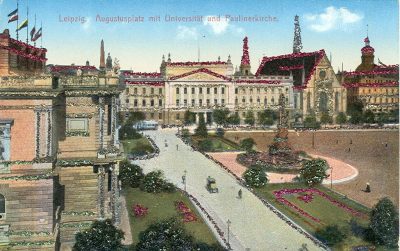
Augustus Platz in Leipzig. Via.
September 9, 1929
Monday. With private auto and guide we start out this morning at 9:30 to see the very interesting city of Leipzig. My impressions are that it is very clean, progressive, home of very specialized industries, chiefly printing to which is devoted a large section of buildings including schools wherein are taught the various sciences there unto appertaining. There is a fine large school where dead and dumb are taught arts and crafts. The university buildings cover a wide area as do also the many hospital buildings each having its specialty but closely grouped together for convenience, the maternity section one of the largest. In Leipzig is located the Supreme Court, highest tribunal of justice in all Germany, delegated to this city by Bismark. Here is the usual fine Opera House met with in German cities and the Cloth Hall Koncert Haus, so named because the Cloth Guild promoted and fostered music in earlier days. We ride through Johanna and Albert Parks, in the former the Bismark Memorial, in the latter the race tracks, past the large and well kept cemetery, the Russian Memorial Church, slightly different in design from the others I have seen. They took the gold plating off the dome during the war when they ran short of metals. One oddity on the street which draws my attention is a hearse and cab each distinct but combined on four wheels and drawn together by two horses. We ride through the fair grounds, over 80 buildings in different parts of town, now closed, in which every spring and fall, all the principal nations compete in trade for one week. The library of the University is a very handsome building. Among the many statues there is one to Luther (this town is chiefly Protestant, there being only one Catholic church here) and another to Habuemann, homeopathist. This latter is fenced around ever since the students played a prank by putting a chamber [pot?] beneath the chair on which the figure is seated. The Augustus Platz, one of the principal squares of the city, is surrounded by handsome buildings, among the others the museum of fine arts where there is a good collection and in the center is the Mendebrummen, a fitting ornament. But the outstanding monument of the city is that of the Battle of the Nations, a huge granite structure standing out in bold relief on a grassy knoll in a park which isolates it. Colossal figures of allegorical conception decorate it without and within, while its acoustic qualities are most remarkable. It is the tallest monument in all Germany.
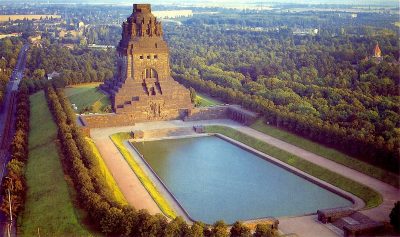
Battle of the Nationals Monument. Via.
This afternoon we ride through a different portion of the city. The second most important industry is furs. Many are seen in the raw and one see some beautiful skins, though there are finished products as well, this being one of the chief fur markets of the world and the Jews have the monopoly of this trade. The residential section of Leipzig is very pretty and the homes are well set off by pretty flower gardens, Karl Tauschnitz Strasse one of the finest. There is one building decorated with frescoes of fairy tales and nursey rhymes, and another occupied by artists studios boldly decorated with murals in bight shades. The Thuringen Hof, 15th century restaurant, has walls painted with scenes from different operas and old wood carvings. The new City Hall is another of the imposing buildings which beautify Leipzig. A statue of Bach stands in front of St. Thomas church where he used to conduct his famous choir. Today is what they call Tauscher, a local fete celebrated by the children and we see many of them in the streets this evening masked and in comic outfits, carrying lanterns. It corresponds somewhat to our Halloween.
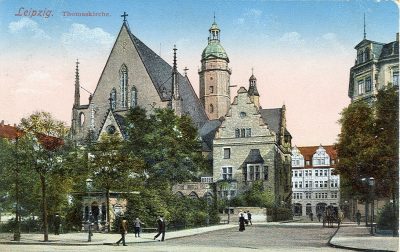
St. Thomas Church. Via.
September 10, 1929
Tuesday. Leipzig. We see more of the old city today, the Old Town Hall with Napoleonic museum, house where the great general lived during the battle of Leipzig. We walk through the shopping district (Petersstrasse the principal street, Theodore Althof the best department store). In Auerbach’s Kellar is where Goethe used to come when he wrote Faust on an old beer cask and the walls are decorated with murals representing scenes from this work. There is a large, well-kept covered market hall in Leipzig, poultry, flowers and fruit predominating, and an underground exhibition hall. This city looks extremely prosperous and it is said to pay more taxes per capita than any other German municipality.
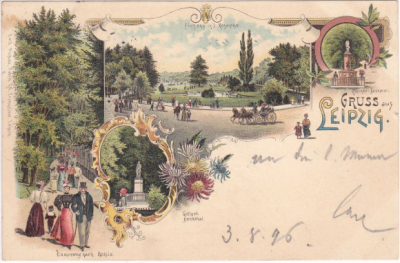
Rosenthal Park. Via.
September 11, 1929
Wednesday. We take a horse drawn vehicle that looks like it might date from Noah’s Ark today and ride through the principal parks including the Rosenthal where autos are not allowed. The people over here make much better use of their parks than we do as they are always much frequented, especially the zoos.
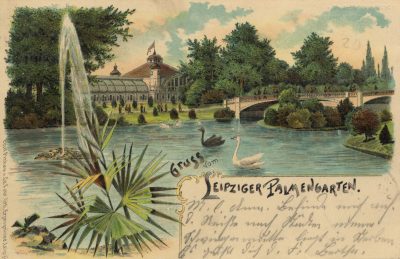
Palmengarten. Via.
September 12, 1929
Thursday, Leipzig. We spend this morning in the beautiful Palmengarten, a pleasant spot indeed in which to dream away a leisure hour or two. The radio is broadcasting a high order of music from Dresden which forms a very fitting complement to the lovely flowers, exotic shrubbery, lakes and fountains. At 4 p.m. we take the train for Magdeburg, the country stretches flatly I the distance. Windmills are a frequent feature of the landscape.
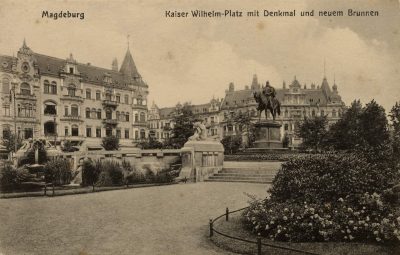
Magdeburg Postcard. Via.
September 13, 1929
Friday. We are at the Magdeburger Hof, the best the city affords, which is not saying much. We ride around today and see the sights of interest. There is an ancient air about the place and yet it is busy with commerce which extends over a great area. It claims four hundred thousand inhabitants, most of whom seem to be on the streets, which are unusually wide. Never have I seen such a crowded thoroughfare as the Breiteweg. The Dom is a fine Gothic structure whose steeples can be seen at a great distance owing the flat country. There are many pretentions homes which bespeak prosperity, a splendid park and the wachshaus where wonderful plants are cultivated, especially cacti here to be seen in every variety, and peppers in many colors. The old town hall is a quaint structure and before it stands the gilded figure of King Otto on horseback beneath its little Moorish cupola. Magdeburg is on the Elbe.
